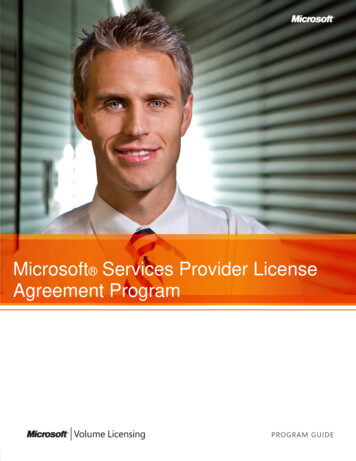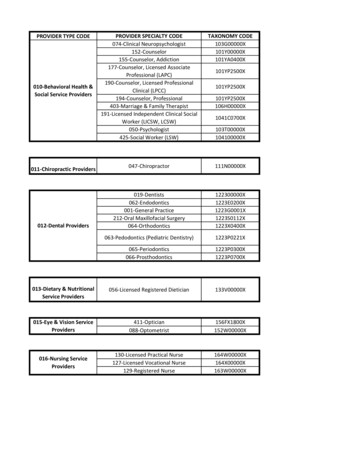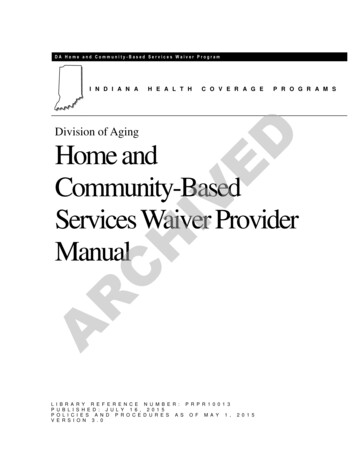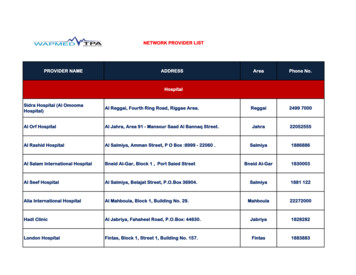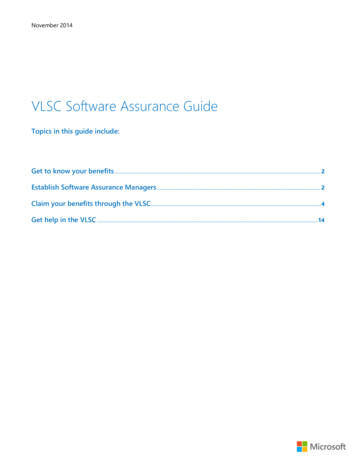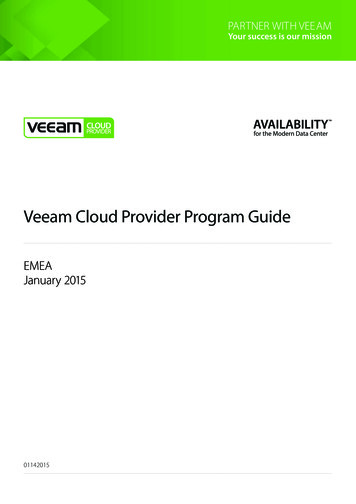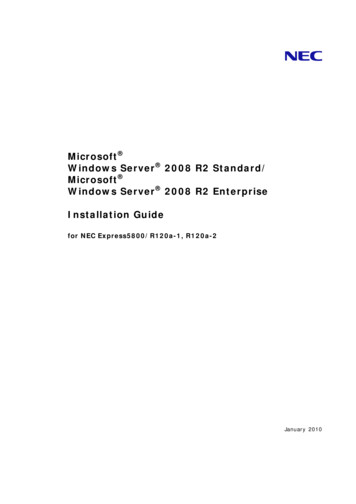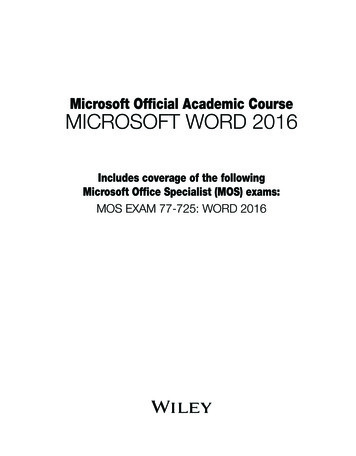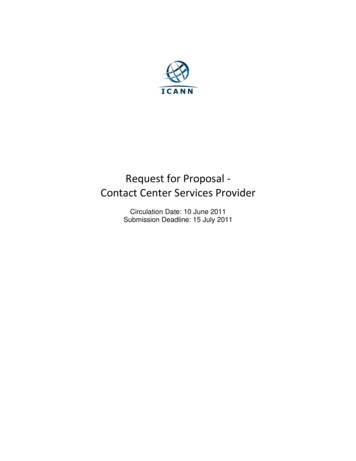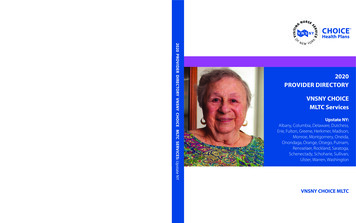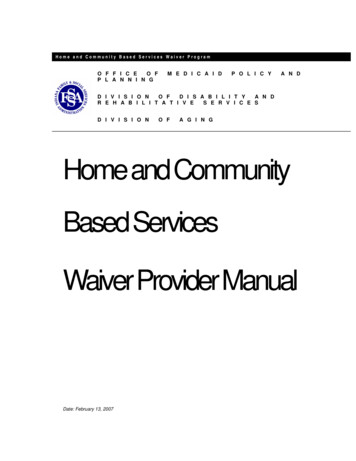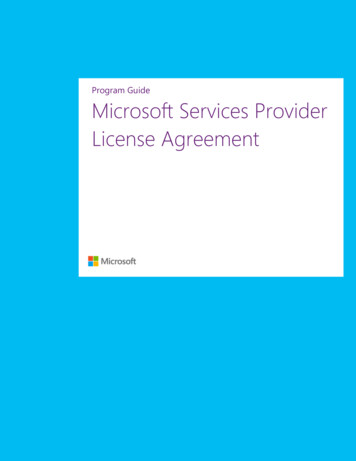
Transcription
Program GuideMicrosoft Services ProviderLicense Agreement
Microsoft Services Provider License AgreementTable of ContentsWhat Is a Service Provider? . 3Benefits . 4Eligibility for the Services Provider License Agreement Program . 5Program Requirements . 5Program Requirements (Continued) . 6Licensing Models Available . 6Participating in the Services Provider License Agreement Program . 7Product Availability . 7Agreement Terms . 7Pricing and Reporting . 8Pricing . 8SPLA Amendments . 8Media and Product Keys . 9Media Ordering and Fulfillment . 9Reporting . 9How to Enroll—Services Provider License Agreement . 10Additional Resources . 11Glossary . 12Microsoft Volume Licensing2
Microsoft Services Provider License AgreementWith the Microsoft Services Provider License Agreement (SPLA), service providers and independent softwarevendors (ISVs) can license eligible Microsoft products on a monthly basis, during a three-year agreementterm, to host software services and applications to end customers. The SPLA program provides the licenserights to host specific Microsoft Products as outlined in the Microsoft Service Provider Use Rights (SPUR).What Is a Service Provider?Service providers offer a variety of software services to customers, such as access to third-party software, platform infrastructureservices, business transaction services, web hosting and streaming media services, and line-of-business (LOB) applications for aspecific business purpose, in a particular industry or sector. Service providers offer customers direct or indirect access toproducts that interact with Microsoft server licensed products (“Products”) offered as software services.Specifically, you are a service provider if you provide the following software services to your customers: Your organization provides your customers with direct or indirect access to products such as hosted websites or LOBapplications through Microsoft server products. Your organization offers your customers software services that interact with Microsoft Products. In this scenario, you, notyour customer, are the licensee. Your organization facilitates your customer’s business, including business transactions with third parties, through softwareservices that interact with Microsoft Products. Your organization provides your customers with access to and use of any application as a software service, Microsoft orotherwise, and the application is running on a server and interacts with a Microsoft product on that server. Your organization offers other service providers platform infrastructure services to use and run any Microsoft or third-partyapplication. This, in turn, allows these other service providers to offer Microsoft applications as a software service to theirend customers through their own SPLA.Software ServicesSoftware services are services that you provide to your customers that make products available and that display, run, access, orotherwise interact with Microsoft products. You provide these services from one or more data centers through the Internet, atelephony network, or a private network on a rental, subscription, or services basis, whether or not the service provider receives afee. The SPLA makes offering software services easier because you are the licensee, not the customer.Microsoft Volume Licensing3
Microsoft Services Provider License AgreementBenefitsThe SPLA Program is an excellent opportunity for service providers to offer customers a single point through which to acquiresoftware services and the associated Microsoft Products so that the customers do not have to acquire and deploy their ownlicensed products. In addition, customers can leverage the flexibility, cost, and management efficiencies of a sharedinfrastructure. The SPLA Program provides a more streamlined way for services providers to give their end customer’s access tofully licensed Microsoft Products as software services. Because the services provider—not the end customer—is the licensee, theSPLA Program reduces the complexity of offering software services.Deliver a customized service. Flexibility to deliver tailored IT services to your customers through a dedicated or sharedhosting environment. Increase the value of your services by managing software use rights for your customers.Pay as you go with no up-front costs. Pay only for licenses based on what you make available to provide software servicesfor each month. There are no start-up costs or long-term commitments.Access the most current product versions. Give your customers the most current and capable Microsoft platform.Download your products at no charge through the Microsoft Volume Licensing Service Center (VLSC) instead of orderingphysical media.Offer software services worldwide. Use Microsoft Products to deliver software services to end customers in and from anypart of the world where distribution is legally allowed.Expand distribution capabilities through Software Services Resellers. Expand business reach to small and midsizebusinesses providing software services through additional resellers.Leverage Data Center Providers for infrastructure capabilities. Have the option to focus on hosting your applicationsolutions and acquire infrastructure as a service (IaaS) from a Data Center Provider, including Windows Azure. (WindowsAzure is also considered a Data Center Provider)Leverage Data Center Outsourcing. Install Microsoft Products on servers under the day-to-day management and control ofan outsourcing company to deliver your software services based on your capacity and server management capabilities. Theoutsourcer can then perform data center administration, testing, and maintenance support services on the end customer’sbehalf.Try before you buy. Test and evaluate products internally before offering them to your customers as a service.Install at customer facilities. Install Microsoft products on servers that are located on an end customer’s premises underyour management and control.Expand your reach to academic institutions. Expand your business with specific price offerings available to your academiccustomers through the SPLA.Offer demonstrations and evaluations. You can give up to 50 user product demos on Microsoft software and provide yourcustomers with a free 60-day trial period.Include your affiliates under a single agreement.Simplified licensing with the Microsoft Business and Services Agreement (MBSA). Once an MBSA is in place, you onlyneed to sign a shorter and more simplified SPLA every three years. It also makes it easier to purchase Premier andProfessional support.Microsoft Volume Licensing4
Microsoft Services Provider License AgreementEligibility for the Services Provider License Agreement ProgramBusiness models and scenarios that the SPLA may be appropriate for include the following: Application service providers Business process outsourcers (BPO) Messaging or collaboration service providers IT outsourcers that provide software licenses PC rental companies Platform infrastructure providers Web hosting providers Streaming media providers ISVs that provide hosted applications Web or Internet service providers1Program RequirementsThis section describes the requirements your organization must meet for the SPLA: Enroll in the Microsoft Partner Network. You must be a member of the Microsoft Partner Network (MPN). Sign a Microsoft Business and Services Agreement. Service providers that have an existing MBSA through another Volume Licensing Agreement (EnterpriseAgreement, Enterprise Subscription Agreement [EAS], Select Plus, or ISV Royalty Licensing) should work with theirMicrosoft account manager and/or reseller to provide their MBSA number and link the MBSA to their SPLA. Service providers without an existing MBSA are required to sign one the next time they sign an SPLA.Designate an SPLA reseller. Work with an SPLA reseller to complete the SPLA and MBSA. The reseller does thefollowing: Collects your monthly use report or zero use report and submits it to Microsoft. Collects payment for the licenses made available to users during the previous month. Assists you on all aspects of the SPLA Program. Select an SPLA reseller via this list, located on the Microsoft.com/hosting site Comply with the Services Provider Use Rights (SPUR). The SPUR specifies use rights and conditions that apply to acustomer's use of the products licensed under the SPLA. Microsoft can revise the SPUR at any time. The SPUR is updatedquarterly and can be found at rch. Provide monthly reporting on software licenses. Submit either a monthly use report of at least US 100 or Zero Usereport (non-consecutive) to your SPLA reseller. You must also report on all licenses that you made available to yourcustomers for your affiliates and software services resellers.Note: You may submit consecutive zero usage reports for the first six months immediately following the signing ofyour SPLA agreement. After the first six usage months, you must begin reporting at least US 100 per month to keepyour SPLA agreement active. 1Submit a monthly invoice payment. The SPLA reseller invoices you monthly based on the number of licenses reportedin your monthly use report. You are responsible for submitting your payment to the SPLA reseller by the agreed date.If you are an ISV, you may offer software services built on your intellectual property (IP) to your customers through servers connected to the Internet ora private network. If Microsoft Products are used to provide these services, it can be licensed through your own internal-use Volume LicensingAgreement, with the requirements as described in the PUR. In this case, an SPLA is not required. The Microsoft Products must indicate “Self-HostedApplications: Yes” in the Product-Specific License Terms section of the Product Use Rights (PUR). Microsoft Software Assurance is required for allMicrosoft licenses used in the delivery of your Unified Solution to your customers.Microsoft Volume Licensing5
Microsoft Services Provider License AgreementProgram Requirements (Continued) Abide by copyright guidelines, the use of trademarks, and antipiracy obligations. Service providers who sign the SPLAmust abide by the requirements for preventing the piracy of Microsoft licensed products and must comply withtrademark and logo use requirements and pass-through copyright and similar notices. You must include Microsoft’scopyright notice on any documentation, including online, for your products and services that include MicrosoftProducts. Affiliates must also follow these requirements. Provide technical support. You are responsible for providing technical product support for the Microsoft Products youdeliver to your customers. Agree to participate in Microsoft SPLA audits. Microsoft and/or its designees can review your records and facilities(including the data centers) to verify compliance and conduct on-location audits if needed. Comply with the export requirements. You need to comply with all applicable export laws, and it is recommended thatyou obtain legal advice regarding the export laws applicable to your business. For informational purposes only,Microsoft has collected information on export requirements and other information, including US export regulations,product Export Control Classification Numbers (ECCNs), and export-restricted products athttp://www.microsoft.com/exporting/.Licensing Models AvailableLicenses acquired under the SPLA are monthly subscription licenses. Please note that not all products are available in the threelicense models. For a list of Microsoft Products available for each license model, review the SPUR document.The following are the licensing models: Per Subscriber: A Subscriber Access License (SAL) is required for each unique individual user or device that is authorizedto access or otherwise use the licensed products. When using the SAL option, a separate Server License is not needed.Examples of products licensed with a SAL are Microsoft Exchange Server, Microsoft Office, and Microsoft Dynamicsbusiness software (CRM).oSALs for Software Assurance (“SALs for SA”) are available for some products to be assigned to customers who havepreviously purchased on-premises Client Access Licenses (CALs) under their separate VL agreement with Microsoftand who continue to maintain Software Assurance on those CALs. With SALs for Software Assurance, thesecustomers can leverage their CALs with active Software Assurance to access an equivalent SPLA software service inthe Partner’s hosted environment. If your customers already have CALs with Software Assurance, you can purchaseSALs for SA at a discounted price versus regular SALs, for these customers. Per Processor: Each Processor License allows an unlimited number of users to access the product that is installed on theserver without a separate SAL. Examples of products licensed through a per-processor model are Windows Server, andMicrosoft Dynamics ERP Products (e.g. NAV, GP). Per Core: Each Core License (CL) allows an unlimited number of users to access the server software installed on theserver without a separate SAL with a determined number of physical cores for products licensed through a per-coremodel. Examples of products licensed through a per-core model are Microsoft SQL Server and Microsoft BizTalk Server.Microsoft Volume Licensing6
Microsoft Services Provider License AgreementParticipating in the Services Provider License Agreement ProgramAfter successfully enrolling in the SPLA program, the following are the key steps for participation: Obtain master copies of the Microsoft Products. You can either download the media through the Microsoft VLSC orpurchase media fulfillment kits for a minimal cost. Provide software services that interact with Microsoft products to your customers. For example, provide your customerswith access to hosted websites or LOB applications through Microsoft software products. Ensure that your customers have agreed to and are provided the required Microsoft End User license terms and userights. Sign the License Mobility Addendum if you plan to become an Authorized Mobility Partner. Your organization’s namewill be added to the list of authorized partners. Visit License Mobility Through Software Assurance for more information.Product AvailabilityYou can access a wide selection of Microsoft Products through the SPLA. Download the most recent SPUR document to learnhow available products are licensed. Some of the top SPLA-selling licensed products, ranging from IT solutions to officeproductivity, are listed below: Windows Server Microsoft SharePoint Hosting Server Microsoft System Center Microsoft Lync Server Microsoft SQL Server Microsoft Dynamics Microsoft Exchange Server Microsoft Office Microsoft SharePoint ServerAgreement TermsThe agreement term is three years. At the end of three years, you can sign a new agreement, let the agreement expire, or extendthe agreement for 12 months or the longest remaining customer agreement period, whichever period is shorter.You must request an extension at least 30 days before your agreement expires. You can only request an extension if you are notsigning new customer agreements and need to provide software services beyond the end of the agreement to existing customeragreements. You cannot provide software services to any new customers or extend any existing customer agreements.You can terminate the agreement with 60 days prior written notice to Microsoft. Within 30 days of your agreement terminatingor expiring, you are required to remove all copies of client software from your customers’ desktop PCs and ensure that yourcustomers return or destroy all copies of client software.Microsoft Volume Licensing7
Microsoft Services Provider License AgreementPricing and ReportingPricingTo find out the price you are charged for each Microsoft Product offered through the SPLA program, please contact your SPLAreseller.Academic PricingAcademic pricing on selected products is available when you deploy services to qualified education customers. Learn more aboutthe Qualified Educational User.Price ChangesMicrosoft can decrease the price in the SPLA Reseller’s price list at any time. Microsoft can increase the price in the SPLAReseller’s price list only once each calendar year on January 1 and at any time to offset exchange rate fluctuations for pricesother than US dollars. If Microsoft increases the price of a particular version of a product after you sign your agreement, you areinvoiced by your SPLA Reseller at the price in effect for that particular product at that time. SPLA Reseller has the right to transferMicrosoft price increases to their price lists and to you as a SPLA Partner.SPLA AmendmentsLicense Mobility through Software Assurance AmendmentWith License Mobility through Software Assurance, Microsoft customers can deploy certain server application licenses with activeSoftware Assurance purchased under their internal use Volume Licensing Agreement in an Authorized Mobility Partner’s datacenter. You are required to sign the License Mobility Addendum to the SPLA to be an Authorized Mobility Partner, but you arenot required to become an Authorized Mobility Partner. Visit Licens
Download your products at no charge through the Microsoft Volume Licensing Service Center (VLSC) instead of ordering physical media. Offer software services worldwide. Use Microsoft Products to deliver software services to end customers in and from any
